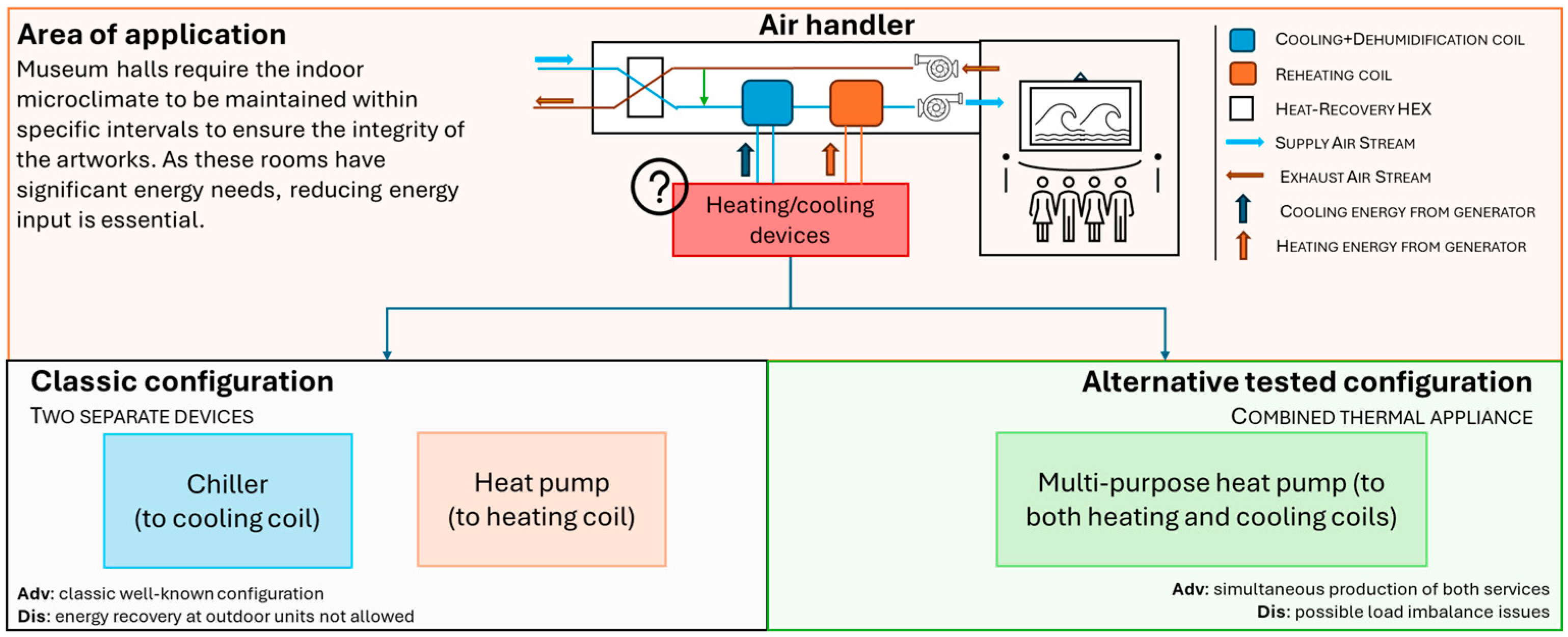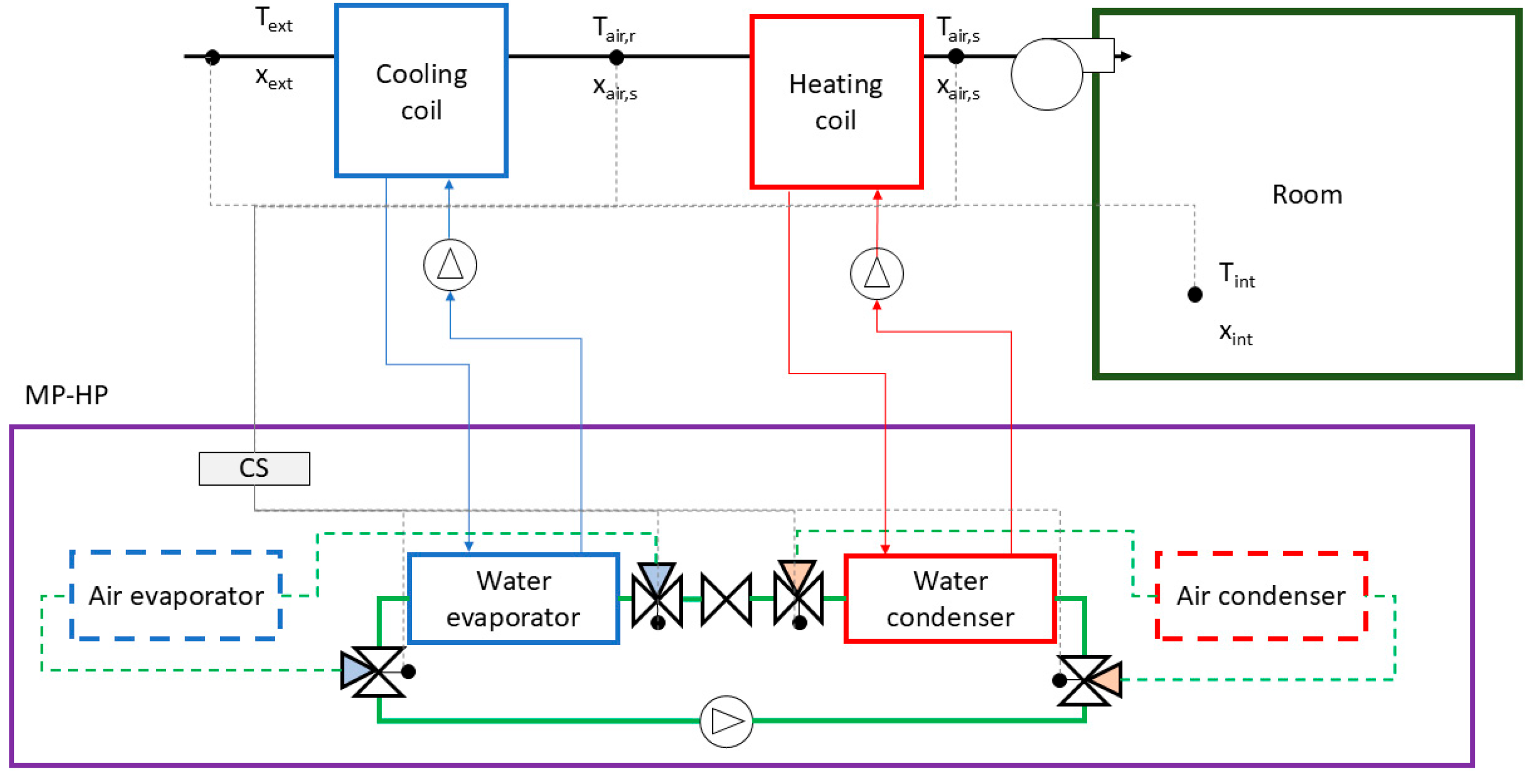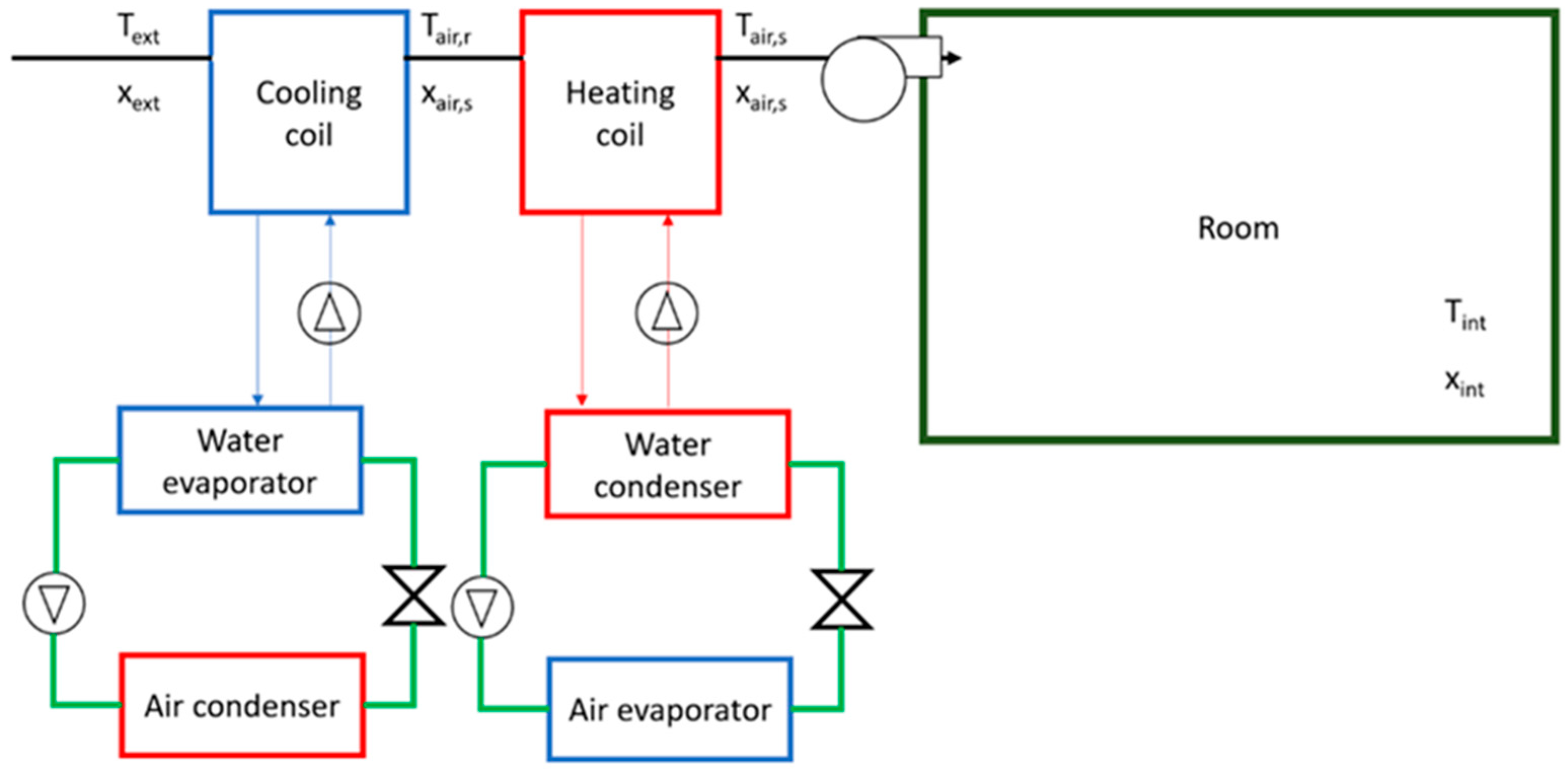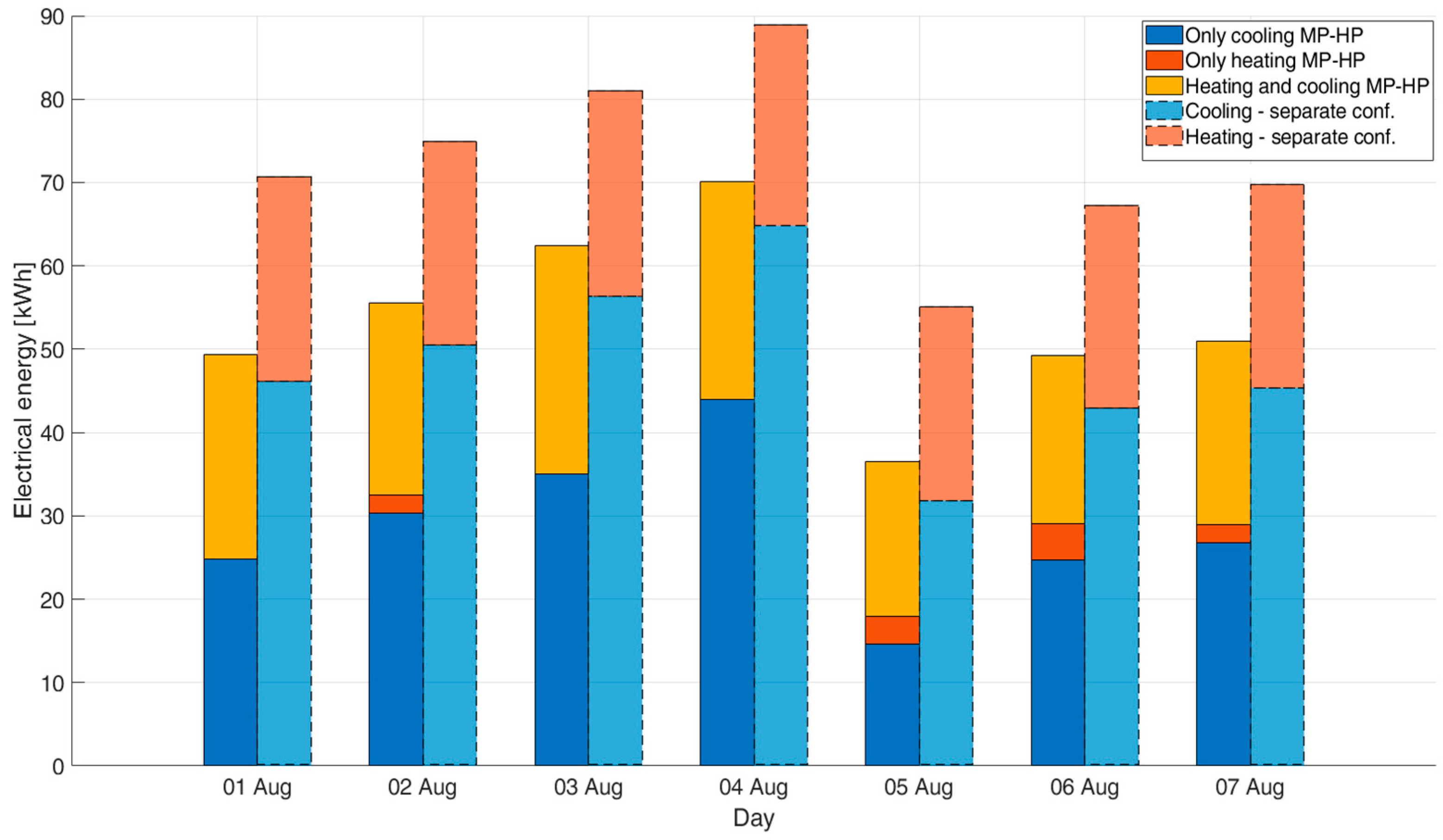Energy Savings Potential of Multipurpose Heat Pumps in Air-Handling Systems
Abstract
1. Introduction
1.1. Context
1.2. Literature Review
1.3. Research Aim
2. The Model
- Section 2.1 presents the dynamic model of a MP-HP system, where the evaporator and the condenser can be simultaneously used for the energy needs of an AHU maintaining a museum room in fixed thermal indoor conditions. Figure 2 shows that when both cooling and heating coil at AHU are operating, both water evaporator and condenser of the MP-HP are used. If one of the two AHU heat exchangers is not necessary, the corresponding MP-HP air OU is used. A control system (CS in the figure) manages the three-way diverter valves, letting the refrigerant moving towards the air- or the water-heat exchanger.
- Section 2.2 presents a classic configuration where energy at the AHU is provided separately by two air-source generators: a heat pump (for the heating coil) and a chiller (for the cooling coil); see Figure 3.
2.1. Configuration Using a Multipurpose Heat Pump (MP-HP)
- Mode 1—Classic chiller: the MP-HP operates as an air-to-water chiller, rejecting thermal energy at the air-source condenser. The compressor absorbs a certain amount of electrical energy, which is function of the supply temperature at AHU () and capacity ratio () as in
- Mode 2—Classic heat pump: the MP-HP operates as an air-to-water heat pump, exchanging thermal energy at the air-source evaporator. The electrical energy absorbed by the compressor is function of the supply temperature at AHU () and capacity ratio () as in
- Mode 3—Multipurpose heat pump: in this configuration, the AHU requires both heating and cooling loads, and both the MP-HP water-source heat exchangers are used. As the loads at heat exchanger can be unbalanced, surplus energy at condenser/evaporator is considered stored in water buffers and later used. The following strategy, based on real implemented control system [23], is used:
- (a)
- The MP-HP tries following the cooling load, providing . This quantity matches the energy actually required at the AHU (). Then, the absorbed electrical energy at the compressor and the thermal energy at the condenser ( and , respectively) are evaluated. Supply temperatures to the reheat and cooling coils ( and , respectively) and partial load conditions () are
- (b)
- The thermal energy at the condenser, , is compared to the energy required at AHU reheat coils,
- (c)
- If , the MP-HP operates in “following cooling load” conditions. The surplus energy at the condenser is stored in a hot buffer. The following equations apply:
- (d)
- If , the MP-HP cannot follow cooling load, as there is not an additional heat generator that could provide the deficit energy at AHU reheat coil. Consequently, the MP-HP operates in “following heating load”, providing an amount of energy at the condenser equal to the one needed at AHU. The surplus energy at evaporator is stored in the cold thermal buffer and later used. The following equations apply:
- For Mode 1 (Classic chiller):
- For Mode 2 (Classic heat pump):
- For Mode 3 (Multipurpose heat pump):
2.2. Classic Configuration (Separate Heat Pump and Chiller)
3. Application to a Case Study for Comparison
3.1. The Case Study
- Indoor temperature: 25 °C, control dead band ±1 K;
- Indoor relative humidity: 50%, control dead band ±2%.
- Outdoor climate values (i.e., ambient temperature, relative humidity, horizontal solar radiation) from a typical meteorological year [35];
- Time-dependent number of visitors inside the museum hall, varying with the day of the week from 9 a.m. to 7 p.m., influencing sensible and latent internal gains [36];
- AHU activated 24/7 to ensure the maintenance of thermal conditions inside the hall.
- TRNSYS [39] is used to estimate the sensible and latent loads required for the museum hall;
- An AHU dynamic model [40] in MATLAB [41] is employed to assess the values of temperature and humidity ratio of the supply air at the beginning and end of each component (e.g., cooling and reheat coils, vaporizer). Mass and heat balance and ϵ-NTU equations are implemented for the simulation of each AHU section. In particular, referring to Figure 2, the values of temperature and humidity ratio exiting the cooling coils ( and ) and reheat coils ( and ) are necessary for the following simulation of the supply temperatures at the generators ( and );
- A dynamic model of the heat generators in the two configurations (MP-HP and classic configuration) is implemented in MATLAB [41], assessing the electrical energy load to guarantee the indoor conditions.
3.2. Parameters of the Dynamic Simulation and Key Performance Indicators Used for Comparison
3.3. Sensitivity Analysis to Climate
4. Results
4.1. Results for the Main Case Study (Pisa)
- for the chiller, mean temperature at the water evaporator/air condenser: 8 °C/23 °C;
- for the heat pump, mean temperature at the air evaporator/water condenser: 23 °C/39 °C.
- in “Mode 1”, mean temperature at the water evaporator/air condenser is 7 °C/25 °C;
- in “Mode 2”, mean temperature at the air evaporator/water condenser is 15 °C/40 °C;
- in “Mode 3”, mean temperature at the water evaporator/water condenser is 8 °C/40 °C.
4.2. Results of the Sensitivity Analysis
5. Conclusions
Author Contributions
Funding
Data Availability Statement
Acknowledgments
Conflicts of Interest
Abbreviations
| Acronyms | |
| AHU | Air handling unit |
| DHW | Domestic hot water |
| HP | Heat pump |
| MP-HP | Multipurpose heat pump |
| nZEB | Nearly zero energy building |
| Nomenclature | |
| Coefficient of performance of the heat pump | |
| Capacity ratio | |
| Electrical energy needs at compressor | |
| Thermal output | |
| Average coefficient of performance | |
| Temperature of the air after the cooling and dehumidification process in the AHU | |
| Temperature of the supply air entering the room | |
| Supply temperature at cooling coil | |
| External temperature | |
| Supply temperature at heating coil | |
| Temperature of the thermal zone (Museum’s rooms) | |
| Total efficiency ratio | |
| Supply temperature ratio | |
| Humidity ratio of the air after the cooling and dehumidification process in the AHU | |
| Humidity ratio of the supply air entering the room | |
| Humidity ratio of the external air | |
| Humidity ratio of the internal air | |
| Coefficients of the polynomial fitting of nameplate data of performances of MP-HP | |
| Subscripts | |
| C | “Only cooling” mode |
| H | “Only heating” mode |
| H&C | “Both heating and cooling” mode |
| MP-HP | Multipurpose heat pump |
| SC | Separate configuration |
| 1 | First try for the MP-HP to follow one of the required load |
References
- United Nations. Sustainable Development Goals. Goal 13: Take Urgent Action to Combat Climate Change and Its Impacts, 2015. Available online: https://www.un.org/sustainabledevelopment/climate-change/ (accessed on 12 April 2025).
- EU Parliament. The European Green Deal, 2019. Available online: https://eur-lex.europa.eu/resource.html?uri=cellar:b828d165-1c22-11ea-8c1f-01aa75ed71a1.0002.02/DOC_1&format=PDF (accessed on 12 April 2025).
- U.S. Government. Inflation Reduction Act of 2022; 2022. Available online: https://www.congress.gov/117/plaws/publ169/PLAW-117publ169.pdf (accessed on 12 April 2025).
- United Nations—Framework Convention on Climate Change, Paris Agreement, 2021. Available online: https://unfccc.int/sites/default/files/resource/parisagreement_publication.pdf (accessed on 12 April 2025).
- Ministry of Ecology and Environment of the People’s Republic of China, China’s Policies and Actions for Addressing Climate Change, 2022. Available online: https://english.mee.gov.cn/Resources/Reports/reports/202211/P020221110605466439270.pdf (accessed on 12 April 2025).
- Australian Government, Australia’s Long-Term Emissions reduction Plan, 2021. Available online: https://www.dcceew.gov.au/sites/default/files/documents/australias-long-term-emissions-reduction-plan.pdf (accessed on 12 April 2025).
- United Kingdom Government—Department for Energy Security and Net Zero, Powering Up Britain: Net Zero Growth Plan, 2023. Available online: https://www.gov.uk/government/publications/powering-up-britain/powering-up-britain-net-zero-growth-plan (accessed on 12 April 2025).
- New Zealand Ministry for the Environment, Climate Change Response (Zero Carbon) Amendment Act 2019, 2019. Available online: https://legislation.govt.nz/act/public/2019/0061/latest/LMS183736.html (accessed on 12 April 2025).
- International Energy Agency (IEA). Installation of About 600 Million Heat Pumps Covering 20% of Building Heating Needs Required by 2030; International Energy Agency (IEA): 2022. Available online: https://www.iea.org/reports/installation-of-about-600-million-heat-pumps-covering-20-of-buildings-heating-needs-required-by-2030 (accessed on 14 June 2025).
- European Heat Pump Association. Subsidies for Residential Heat Pumps in Europe; European Heat Pump Association: 2023. Available online: https://www.ehpa.org/wp-content/uploads/2023/03/EHPA_Subsidies-for-residential-heat-pumps-in-Europe_FINAL_March-2023.pdf (accessed on 14 June 2025).
- US Department of Energy. Making Our Homes More Efficient: Clean Energy Tax Credits for Consumers; US Department of Energy: 2022. Available online: https://www.energy.gov/policy/articles/making-our-homes-more-efficient-clean-energy-tax-credits-consumers (accessed on 14 June 2025).
- Statista. Annual Sales of Heat Pumps in Europe from 1990 to 2022; Statista: 2023. Available online: https://www.statista.com/statistics/1191798/heat-pump-sales-europe/ (accessed on 14 June 2025).
- European Heat Pump Association (EHPA), Market Data. 2022. Available online: https://www.ehpa.org/market-data/ (accessed on 14 June 2025).
- European Commission, Heat Pumps. 2025. Available online: https://energy.ec.europa.eu/topics/energy-efficiency/heat-pumps_en (accessed on 17 June 2025).
- European Commission, National Energy and Climate Plans. 2025. Available online: https://commission.europa.eu/energy-climate-change-environment/implementation-eu-countries/energy-and-climate-governance-and-reporting/national-energy-and-climate-plans_en (accessed on 17 June 2025).
- European Union, REPowerEU Plan. 2022. Available online: https://eur-lex.europa.eu/legal-content/EN/TXT/?uri=COM%3A2022%3A230%3AFIN&qid=1653033742483 (accessed on 12 April 2025).
- ASHRAE. Applied Heat Pump and Heat Recovery Systems. In ASHRAE Handbook—HVAC Systems and Equipment; ASHRAE: Atlanta, GA, USA.
- Kingston, T.; Zhong, Y.; Suchorabski, D. Experimental evaluation of a multipurpose heat pump for space heating and domestic hot-water draw. ASHRAE Trans. 2014, 120, 192–199. [Google Scholar]
- Biglia, A.; Ferrara, M.; Fabrizio, E. On the real performance of groundwater heat pumps: Experimental evidence from a residential district. Appl. Therm. Eng. 2021, 192, 116887. [Google Scholar] [CrossRef]
- González, L.; Romero, J.; Saavedra, N.; Garrido, J.M.; Quinteros-Lama, H.; González, J. Heat Pump Performance Mapping for Energy Recovery from an Industrial Building. Processes 2024, 12, 1955. [Google Scholar] [CrossRef]
- Akbarzadeh, S.; Sefidgar, Z.; Valipour, M.S.; Elmegaard, B.; Arabkoohsar, A. A comprehensive review of research and applied studies on bifunctional heat pumps supplying heating and cooling. Appl. Therm. Eng. 2024, 257, 124280. [Google Scholar] [CrossRef]
- Agrawal, N.; Bhattacharyya, S. Experimental investigations on adiabatic capillary tube in a transcritical CO2 heat pump system for simultaneous water cooling and heating. Int. J. Refrig. 2011, 34, 476–483. [Google Scholar] [CrossRef]
- Cho, C.; Choi, J.M. Experimental investigation of a multi-function heat pump under various operating modes. Renew. Energy 2013, 54, 253–258. [Google Scholar] [CrossRef]
- Liu, X.; Lau, S.K.; Li, H. Optimization and analysis of a multi-functional heat pump system with air source and gray water source in heating mode. Energy Build. 2014, 69, 1–13. [Google Scholar] [CrossRef]
- Wang, Z.; Luther, M.B.; Siamas, A.; Matthews, J.; Liu, C. Development and performance testing of a polyvalent heat pump for hot and cold water production. Archit. Sci. Rev. 2024, 67, 309–320. [Google Scholar] [CrossRef]
- Lee, Y.; Shin, D.U. Development of load-reset-control method for energy saving and comfort improvement in simultaneous heating and cooling system. J. Build. Eng. 2025, 109, 113015. [Google Scholar] [CrossRef]
- Byrne, P.; Miriel, J.; Lenat, Y. Design and simulation of a heat pump for simultaneous heating and cooling using HFC or CO2 as a working fluid. Int. J. Refrig. 2009, 32, 1711–1723. [Google Scholar] [CrossRef]
- Byrne, P.; Miriel, J.; Lenat, Y. Experimental study of an air-source heat pump for simultaneous heating and cooling—Part 1: Basic concepts and performance verification. Appl. Energy 2011, 88, 1841–1847. [Google Scholar] [CrossRef]
- Byrne, P.; Miriel, J.; Lenat, Y. Experimental study of an air-source heat pump for simultaneous heating and cooling—Part 2: Dynamic behaviour and two-phase thermosiphon defrosting technique. Appl. Energy 2011, 88, 3072–3078. [Google Scholar] [CrossRef]
- Dubey, S.; Guruchethan, A.M.; Reddy, Y.S.K.; Maiya, M.P. Energy, environmental and economic analysis of low GWP refrigerant heat pumps for simultaneous heating and cooling applications. Therm. Sci. Eng. Prog. 2024, 51, 102605. [Google Scholar] [CrossRef]
- Diaby, A.T.; Byrne, P.; Maré, T. Simulation of heat pumps for simultaneous heating and cooling using CO2. Int. J. Refrig. 2019, 106, 616–627. [Google Scholar] [CrossRef]
- Shen, B.; New, J.; Baxter, V. Air source integrated heat pump simulation model for EnergyPlus. Energy Build. 2017, 156, 197–206. [Google Scholar] [CrossRef]
- Ghoubali, R.; Byrne, P.; Miriel, J.; Bazantay, F. Simulation study of a heat pump for simultaneous heating and cooling coupled to buildings. Energy Build. 2014, 72, 141–149. [Google Scholar] [CrossRef]
- AERMEC, Technical Datasheet of Multi-Functional Heat Pump. 2025. Available online: https://global.aermec.com/en/products/product-sheet/?Code=NRP_PO (accessed on 12 April 2025).
- CTI (Italian Thermotechnical Committee), Italian Typical Meteorological Years. 2012. Available online: https://www.cti2000.it/index.php?controller=news&action=show&%20newsid=34985 (accessed on 14 June 2024).
- Schito, E.; Testi, D. A visitors’ presence model for a museum environment: Description and validation. Build. Simul. 2017, 10, 977–987. [Google Scholar] [CrossRef]
- Schito, E.; Testi, D. Integrated maps of risk assessment and minimization of multiple risks for artworks in museum environments based on microclimate control. Build. Environ. 2017, 123, 585–600. [Google Scholar] [CrossRef]
- Schito, E.; Conti, P.; Urbanucci, L.; Testi, D. Multi-objective optimization of HVAC control in museum environment for artwork preservation, visitors’ thermal comfort and energy efficiency. Build Environ. 2020, 180, 107018. [Google Scholar] [CrossRef]
- Klein, S. TRNSYS version 17, A Transient System Simulation Program; Thermal Energy System Specialists, LLC: Madison, WI, USA, 2019.
- Schito, E. Dynamic simulation of an air handling unit and validation through monitoring data. In Energy Procedia; Elsevier Ltd.: Amsterdam, The Netherlands, 2018; pp. 1206–1213. [Google Scholar] [CrossRef]
- MATLAB version R2022b, MathWorks: Natick, MA, USA, 2022.
- Huld, T.; Müller, R.; Gambardella, A. A new solar radiation database for estimating PV performance in Europe and Africa. Sol. Energy 2012, 86, 1803–1815. [Google Scholar] [CrossRef]







| 43.0 | 14.0 | 3.07 | 46.4 | 12.9 | 3.61 | 52.5 | 10.9 | 4.80 | ||
| 49.8 | 14.7 | 3.39 | 53.8 | 13.7 | 3.92 | 59.8 | 11.5 | 5.21 | ||
| 54.2 | 15.1 | 3.58 | 57.2 | 14.0 | 4.09 | 63.6 | 11.9 | 5.35 | ||
| 23.7 | 6.3 | 3.75 | 25.5 | 5.8 | 4.41 | 28.9 | 4.9 | 5.87 | ||
| 27.4 | 6.6 | 4.15 | 29.6 | 6.2 | 4.79 | 32.9 | 5.2 | 6.36 | ||
| 29.8 | 6.8 | 4.38 | 31.5 | 6.3 | 4.99 | 35.0 | 5.4 | 6.54 | ||
| 48.8 | 10.6 | 3.05 | 30.8 | 12.8 | 2.41 | 28.5 | 15.8 | 1.83 | ||
| 55.7 | 11.0 | 4.45 | 46.0 | 13.2 | 3.48 | 42.3 | 16.0 | 2.65 | ||
| 32.2 | 11.1 | 5.02 | 53.4 | 13.3 | 4.00 | 46.7 | 16.1 | 3.08 | ||
| 15.4 | 4.8 | 3.39 | 23.0 | 5.8 | 2.67 | 14.3 | 7.0 | 2.03 | ||
| 24.4 | 4.9 | 4.95 | 26.7 | 5.9 | 3.87 | 21.2 | 7.2 | 2.94 | ||
| 27.8 | 5.0 | 5.58 | 15.4 | 6.0 | 4.45 | 24.8 | 7.2 | 3.43 | ||
| 49.6 | 11.3 | 4.37 | 45.2 | 13.4 | 3.38 | 36.3 | 15.9 | 2.28 | ||
| 54.8 | 11.9 | 4.61 | 46.3 | 17.6 | 2.64 | 41.5 | 16.5 | 2.52 | ||
| 61.1 | 12.6 | 4.87 | 56.8 | 14.6 | 3.89 | 48.4 | 17.1 | 2.82 | ||
| 28.3 | 5.10 | 5.34 | 24.9 | 6.01 | 4.14 | 19.9 | 7.17 | 2.78 | ||
| 30.2 | 5.35 | 5.64 | 25.4 | 7.90 | 3.22 | 22.8 | 7.41 | 3.08 | ||
| 33.6 | 5.65 | 5.95 | 31.2 | 6.56 | 4.76 | 26.6 | 7.71 | 3.45 | ||
|
Pisa, IT |
Vancouver, CA |
Bangkok, TH | |
|---|---|---|---|
| Ambient average temperature [°C] | 23.1 | 18.6 | 28.1 |
| Ambient average relative humidity [%] | 74 | 72 | 77 |
| Ambient average humidity ratio [gw/kgda] | 12.6 | 9.5 | 18.3 |
|
MP-HP conf. |
Classic conf. | |
|---|---|---|
| Total cooling load required at AHU [MWh] | 13.9 | 13.9 |
| Total heating load required at AHU [MWh] | 8.8 | 8.8 |
| [MWh] | 3.6 | 4.6 |
| Mode 1—Classic chiller | ||
| Cooling load provided [MWh] | 7.5 | 13.9 |
| Share of cooling load provided [%] | 53 | 100 |
| 4.50 | 4.57 | |
| Mode 2—Classic heat pump | ||
| Heating load provided [MWh] | 0.5 | 8.8 |
| Share of heating load provided [%] | 5 | 100 |
| 5.05 | 5.81 | |
| Mode 3—Multipurpose heat pump | ||
| Cooling load provided [MWh] | 6.4 | n.a. |
| Share of cooling load provided [%] | 47 | n.a. |
| Heating load provided [MWh] | 8.3 | n.a. |
| Share of heating load provided [%] | 95 | n.a. |
| 3.49–4.52 | n.a. | |
| 6.32 | 4.98 | |
| Pisa (IT) | Vancouver (CA) | Bangkok (TH) | ||||
|---|---|---|---|---|---|---|
| MP-HP conf. | Classic conf. | MP-HP conf. | Classic conf. | MP-HP conf. | Classic conf. | |
| Total cooling load required at AHU [MWh] | 13.9 | 13.9 | 9.7 | 9.7 | 28.8 | 28.8 |
| Total heating load required at AHU [MWh] | 8.8 | 8.8 | 9.2 | 9.2 | 9.1 | 9.1 |
| [MWh] | 3.6 | 4.6 | 2.6 | 3.5 | 7.5 | 8.7 |
| Mode 1—Classic chiller | ||||||
| Cooling load provided [MWh] | 7.5 | 13.9 | 2.8 | 9.7 | 21.8 | 28.8 |
| Share of cooling load provided [%] | 53 | 100 | 29 | 100 | 76 | 100 |
| 4.50 | 4.57 | 5.03 | 4.93 | 4.01 | 4.03 | |
| Mode 2—Classic heat pump | ||||||
| Heating load provided [MWh] | 0.5 | 8.8 | 0.2 | 9.2 | 0 | 9.1 |
| Share of heating load provided [%] | 5 | 100 | 2 | 100 | 0 | 100 |
| 5.05 | 5.81 | 5.41 | 5.89 | - | 5.95 | |
| Mode 3—Multipurpose heat pump | ||||||
| Cooling load provided [MWh] | 6.4 | n.a. | 6.9 | n.a. | 7.0 | n.a. |
| Share of cooling load provided [%] | 47 | n.a. | 71 | n.a. | 24 | n.a. |
| Heating load provided [MWh] | 8.3 | n.a. | 9.0 | n.a. | 9.1 | n.a. |
| Share of heating load provided [%] | 95 | n.a. | 98 | n.a. | 100 | n.a. |
| 3.49–4.52 | n.a. | 3.44–4.49 | n.a. | 3.39–4.41 | n.a. | |
| 6.32 | 4.98 | 7.32 | 5.36 | 5.03 | 4.37 | |
Disclaimer/Publisher’s Note: The statements, opinions and data contained in all publications are solely those of the individual author(s) and contributor(s) and not of MDPI and/or the editor(s). MDPI and/or the editor(s) disclaim responsibility for any injury to people or property resulting from any ideas, methods, instructions or products referred to in the content. |
© 2025 by the authors. Licensee MDPI, Basel, Switzerland. This article is an open access article distributed under the terms and conditions of the Creative Commons Attribution (CC BY) license (https://creativecommons.org/licenses/by/4.0/).
Share and Cite
Schito, E.; Conti, P. Energy Savings Potential of Multipurpose Heat Pumps in Air-Handling Systems. Energies 2025, 18, 3259. https://doi.org/10.3390/en18133259
Schito E, Conti P. Energy Savings Potential of Multipurpose Heat Pumps in Air-Handling Systems. Energies. 2025; 18(13):3259. https://doi.org/10.3390/en18133259
Chicago/Turabian StyleSchito, Eva, and Paolo Conti. 2025. "Energy Savings Potential of Multipurpose Heat Pumps in Air-Handling Systems" Energies 18, no. 13: 3259. https://doi.org/10.3390/en18133259
APA StyleSchito, E., & Conti, P. (2025). Energy Savings Potential of Multipurpose Heat Pumps in Air-Handling Systems. Energies, 18(13), 3259. https://doi.org/10.3390/en18133259








